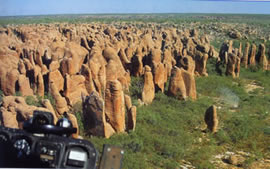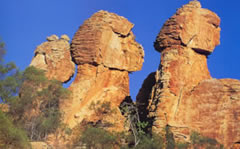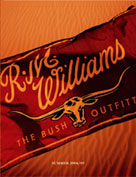ADVENTURE
The Lost Cities discovered
Story and photos Colin Kerr
 They
are as mysterious as they're intriguing, as fascinating as spectacular, and
as "undiscovered" as anything so substantial in the outback. Hidden away in several locations
in the Northern Territory's Top End stand a series of towering "city-like" formations that, until recently, have been seen by few people.
They
are as mysterious as they're intriguing, as fascinating as spectacular, and
as "undiscovered" as anything so substantial in the outback. Hidden away in several locations
in the Northern Territory's Top End stand a series of towering "city-like" formations that, until recently, have been seen by few people.
But this, it seems, is about to change.
The so-called Lost City of Litchfield National Park and, 600 kilometres east,
formations in the Cape Crawford-Nathan River region, are 500 million to 1.2
billion year-old columns, standing like forlorn statues in clusters resembling
city skyscrapers and in large formations that could be mistaken for ancient
cities and their "suburbs".
Some say they rival Uluru/Kata Tjuta and the Bungle Bungles as a natural
outback wonder.
Litchfield's "lost city" is
relatively accessible at the end of a rough, narrow 4WD track, 10.5 km off
one of the park's main roads. The final 2km of this track is, however, tough
going. But it's worthwhile, for at the track's end, spread over the size
of a small town in an otherwise flat countryside, is a series of spectacular
tall sandstone towers.
 From
a distance they most surely resemble the ruined remains of a centuries-old
stone city. Wandering among tall grass between the eroded formations it isn't
difficult to believe you are walking through the streets of a long-abandoned
city centre, the remnants of an extinct civilisation.
From
a distance they most surely resemble the ruined remains of a centuries-old
stone city. Wandering among tall grass between the eroded formations it isn't
difficult to believe you are walking through the streets of a long-abandoned
city centre, the remnants of an extinct civilisation.
There are narrow alleys, sharp corners, open courtyards, one-way streets,
even dead ends. Some feature window and door-like shapes - all there in sandstone,
frozen in time. Were, in fact, these structures actually man-made, with Mother
Nature simply reclaiming the ruins? Or were they built by a forgotten race
of giants?
Out here you can really let your imagination flow! Geologically, the
large free-standing pillars are the result of millions of years of weathering
of the Table Top Range. The softer rock sections have eroded, leaving harder,
more resilient pieces to crumble at a much slower rate, as is happening today. ![]()
Full story: Issue 22, April/ May 2002


